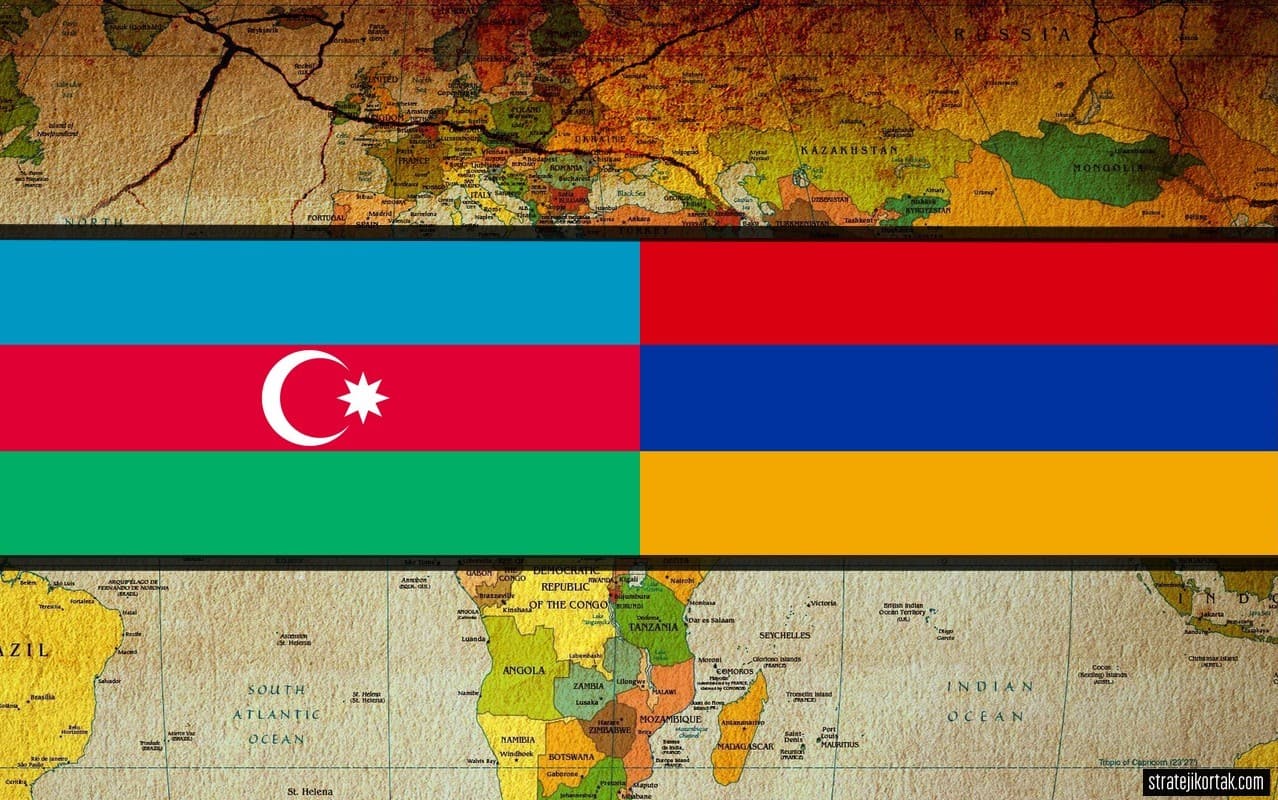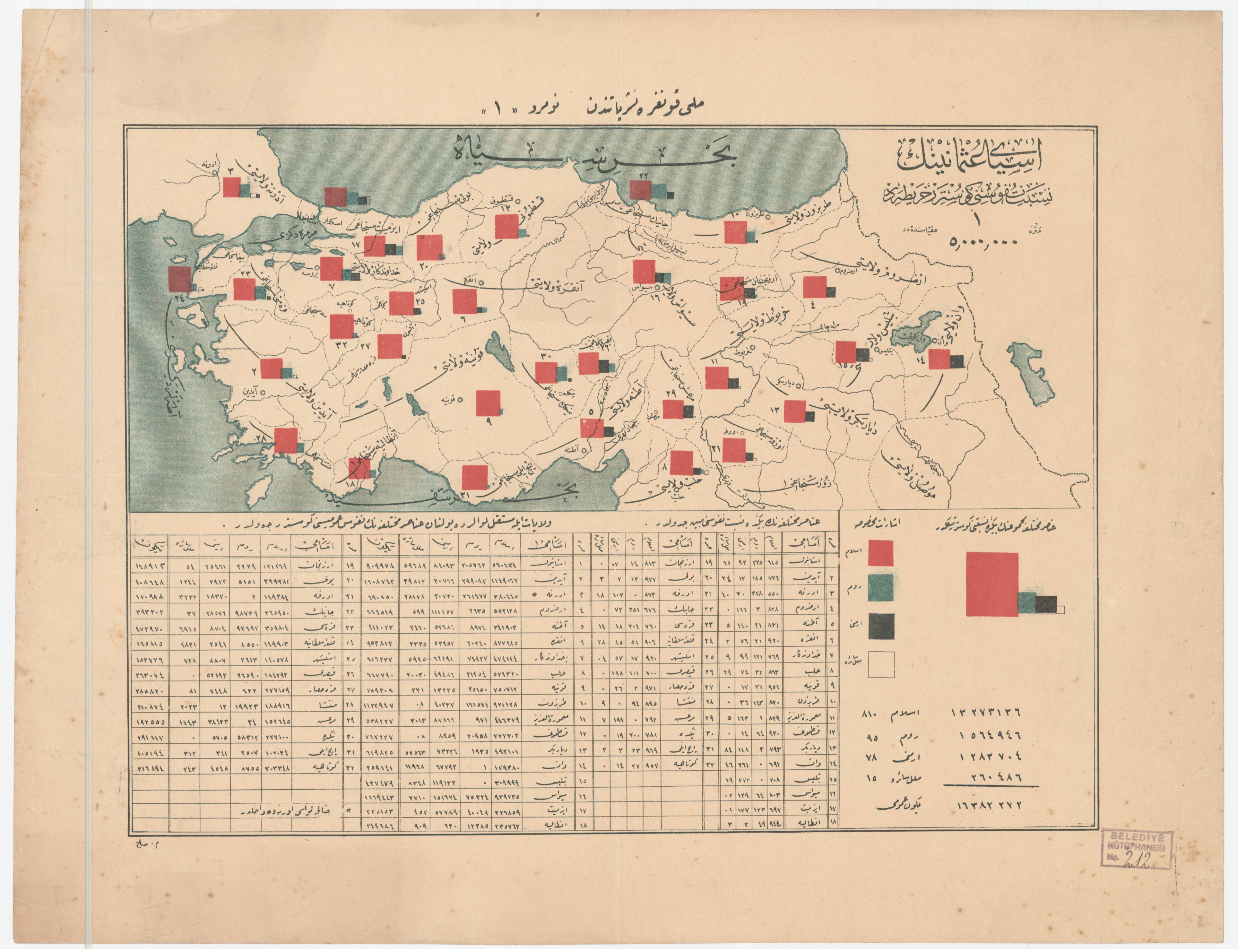
Following the 2020 Karabakh war between Azerbaijan and Armenia, the security perception in the South Caucasus began to change rapidly. Even though establishing a 3+3 platform was offered to the regional countries in order to ensure regional peace, no positive development has occurred so far. Topics such as the tension that ensued on the border between Azerbaijan and Iran, the issue of the Armenia-Azerbaijan border’s delimitation, and the delay of the promised Zangezur corridor due to Armenia perceiving it as a security threat indicate that the security dilemma may persist for a while.
As is known, border delimitation activities between Armenia and Azerbaijan were initiated under the leadership of Russia. The attempts of the EU, France, and the US to get involved in the equation of the region during the tension on the Armenia-Azerbaijan border was a conspicuous development. [1] The war started by Russia against Ukraine on February 2022 was particularly interpreted as a shift of Russia’s focus away from the region. This shift of Russia and the West’s interest towards the region was considered as an opportunity for Armenia to free itself from its dependency on Russia. In fact, Nikol Pashinyan’s, who is known for his anti-Russia stance before his election, rapprochement with the West and NATO even before the 2020 Karabakh War rang alarm bells for Russia. In 2020, during the operation initiated by Azerbaijan for the liberation of its occupied lands, Armenian officials expected Russia’s support (actually as part of the Collective Security Treaty-CSTO), however, they did not receive the help they expected. On top of that, the statements coming from Russia demanding the start of preparations for the opening of the Zengezur road as part of the truce of 9 November indicate that there is a conflict of interest between Russia and Armenia. It is being discussed whether the alliance with Russia is beneficial to Armenia and whether it is possible to leave the CSTO.[2]
These discussions have become more salient following the protests started by Azerbaijani environmental activists on the Lachin road. This is because, following the case of Azerbaijani authorities being prevented by the Armenian separatists from inspecting the environmental pollution in the areas in Khankendi and its surroundings which are being held by separatists, Azerbaijani environmental activists started protests on the Lachin road. The Armenian side appealed to organizations such as the United Nations and the International Court of Justice, claiming that the said actions pose a threat to the security of Armenians. On the other hand, Prime Minister Pashinyan's allegations that the Russian Peacekeeping Force could not fulfil or is not fulfilling its task also escalated the tension between Russia and Armenia.[3]
Behind all these developments, it is seen that there are some other incidents aimed at redesigning the security of Armenia without the involvement of Russia.[4]
There have been a number of interesting visits to Armenia in the past months. As one may recall, the Armenian Prime Minister made some personnel changes claiming that there were intelligence leaks during the Karabakh war. Following the investigations launched after these reassignments, there were some news reports claiming that some intelligence was leaked through the Russian social media platform Odnok.[5] In addition, Pashinyan made claims to the press that there was a coup attempt planned against his administration. Operations launched during that time paved the way for the reforming of the system of intelligence in Armenia which had been maintained since the Soviet period. A series of contacts began to take place as part of establishing a foreign intelligence service that would report directly to the prime minister. For the first time in its history, the CIA US Director visited Armenia, followed by the Armenian Defense Minister’s visits to the CIA and the UK. And lastly, the Chief of MI6 paid a visit to Yerevan.[6] These visits pointed out that the new intelligence agency that will be established in Armenia will be designed within the framework of the aspiration to act independently from Russia.
For the US and the UK, achieving such an impact in Armenia is very important with regard to the process that started with the Ukraine war. Despite the discussions taking place in Georgia with the intention of forming a second front against Russia, it is understood that the second front established against Russia from behind the scenes is in fact Armenia. As a matter of fact, some international organizations are publishing risk analyses explaining that the risk of conflict in the region has risen again.[7] The appointment of the former Deputy Ambassador of Ukraine as Ambassador to Armenia by the US seems to be one of the indicators of this situation.[8]
Will Iran Realize That It Might Be Making Some Miscalculations?
The possibility that the US and the UK will support such activity in Armenia and create an intelligence network on their own axis constitutes a threat to Iran as well as Russia. However, Iran interprets the threats from the region from a narrower perspective and evaluates them from the axis of the South Azerbaijan issue. Iran, which reacts to the Zangezur road as much as Armenia, considers Turkey and Azerbaijan as threats due to Turkey’s NATO membership and Azerbaijan’s alliance with Israel. Moreover, Iran considers the transportation route between Turkey and Azerbaijan as a corridor of the Turkish world.
Iran's most reliable route on the North-South line passes through Armenia. The creation of a possible line on the Zangezur corridor would be considered as obstructing the North-South route for Iran (which connects Iran with Russia). However, the increasing Western influence in Armenia is also not a good sign for Iran. Likewise, when the possibility of Westerners installing themselves in Armenia is added to the crisis that the Iranian regime is experiencing due to its internal problems, it seems that a greater threat, such as a future encirclement of Iran through Armenia, may occur.
An Overlap of Conflicting Interests and Security Concerns
It is necessary to evaluate the interest shown by the US and Western countries towards the South Caucasus region, not only in terms of its connection with Russia and Iran but also with regard to its connection with China and India. Due to the sanctions imposed, direct transportation and gas procurement from Russia to Europe have been ceased. In this circumstance, the importance of the Middle Corridor and TANAP is increasing. However, for the US, which prioritizes the goal of stopping the rise of China in its security documents, having control over this corridor is of significant importance.
Azerbaijan and Turkey, on the other hand, want to provide transportation via Zangezur, as a supporting line, in a shorter time and with less cost. However, India and Iran, the most prominent supporters of the North-South route, seem to believe that the project poses a threat to them. Analyzes in India argue that investing in Russia's ally, Armenia, will benefit India. On the other hand, Azerbaijan’s close relations with Pakistan and Turkey are being perceived as a threat to India's own region.[9] In this context, it is noteworthy that extensive arms sales agreements have been made between Armenia and India.
Although it is not possible for Armenia to leave the CSTO or to take away Russia’s monopoly on security in the short term, it seems that there is a power vacuum in the region and different states are eager to fill this gap. It is understood that Armenia is trying to make up for what it lost in the 2020 war by seeking as much support as it can, and in this context, it is trying to attract different parties into the region. However, since the interests of these powers will bring along conflicts that may threaten the future of the region, it is necessary to act very carefully. All these indicate that the security equation of the region may change radically.
[1] Tutku Dilaver, “Ermenistan Dış Politikasındaki Eksen Kayması, Sınır Anlaşmazlıkları ve Batı’nın Bölgeye Dönüşü” AVİM, https://avim.org.tr/tr/Analiz/ERMENISTAN-DIS-POLITIKASINDAKI-EKSEN-KAYMASI-SINIR-ANLASMAZLIKLARI-VE-BATI-NIN-BOLGEYE-DONUSU.
[2] “Opposition Groups Call For Armenia's Withdrawal From CSTO On Eve Of Yerevan Summit,” 23 November 2022, https://www.rferl.org/a/armenia-csto-protest-russia-azerbaijan/32144702.html
[3] “Ermenistan Rusya arasında Laçin koridoru gerilimi,” AGOS, 31 December 2022, https://www.agos.com.tr/tr/yazi/27971/ermenistan-rusya-arasinda-lacin-koridoru-gerilimi.
[4] “How the South Caucasus Breaks Free from Russian Influence,” European Pravda, 20 July 2022, https://www.eurointegration.com.ua/eng/news/2022/07/20/7143518/.
[5] “Another 'Armenian spy' is on trial in Azerbaijan,” News.am, 28 December 2022, https://news.am/eng/news/737498.html.
[6] For further reading: Turgut Kerem Tuncel, “A NEW FOREIGN INTELLIGENCE AGENCY IN ARMENIA” AVİM, 2 Ocak 2023, https://avim.org.tr/en/Yorum/A-NEW-FOREIGN-INTELLIGENCE-AGENCY-IN-ARMENIA
[7] “Ten conflicts to Watch in 2023,” International Crisis Group, https://www.crisisgroup.org/visual-explainers/10-conflicts-2023/.
[8] “Kristina Kvien confirmed as new US ambassador to Armenia,” Civil.net, 14 December 2022, https://www.civilnet.am/en/news/685975/kristina-kvien-confirmed-as-new-us-ambassador-to-armenia/
[9] “Armenia–India Relations: From Politics to Arms Trade,” https://armenianweekly.com/2022/10/05/armenia-india-relations-from-politics-to-arms-trade/
© 2009-2025 Center for Eurasian Studies (AVİM) All Rights Reserved
No comments yet.
-
 FROM POINT SHOTS TO ARMED CONFLICT: HOW DID AZERBAIJAN-ARMENIA REACH THE BRINK OF WAR?
FROM POINT SHOTS TO ARMED CONFLICT: HOW DID AZERBAIJAN-ARMENIA REACH THE BRINK OF WAR?
Tutku DİLAVER 14.08.2020 -
 AZERBAIJAN-ARMENIA ARMED CONFLICT'S REFLECTIONS BEYOND THE REGION
AZERBAIJAN-ARMENIA ARMED CONFLICT'S REFLECTIONS BEYOND THE REGION
Tutku DİLAVER 30.07.2020 -
 FROM THE DRAWERS OF ANKARA TO THE DUSTY SHELVES OF ARMENIA: ZURICH PROTOCOLS
FROM THE DRAWERS OF ANKARA TO THE DUSTY SHELVES OF ARMENIA: ZURICH PROTOCOLS
Tutku DİLAVER 16.03.2018 -
IGNORED DANGER: MEDZAMOR NUCLEAR POWER PLANT
Tutku DİLAVER 19.12.2018 -
 THE FOREIGN POLICY SHIFT IN ARMENIA, BORDER DISPUTES AND THE WESTERN POWERS’ RETURN TO THE REGION
THE FOREIGN POLICY SHIFT IN ARMENIA, BORDER DISPUTES AND THE WESTERN POWERS’ RETURN TO THE REGION
Tutku DİLAVER 04.11.2022
-
 STATISTICAL INFORMATION REGARDING OTTOMAN ARMENIANS AND FOREIGN RESOURCES
STATISTICAL INFORMATION REGARDING OTTOMAN ARMENIANS AND FOREIGN RESOURCES
AVİM 25.10.2021 -
 UNITED STATES OF AMERICA CONTINUES ITS HABITS
UNITED STATES OF AMERICA CONTINUES ITS HABITS
Hazel ÇAĞAN ELBİR 08.02.2018 -
 AZERBAIJAN-ARMENIA ARMED CONFLICT'S REFLECTIONS BEYOND THE REGION
AZERBAIJAN-ARMENIA ARMED CONFLICT'S REFLECTIONS BEYOND THE REGION
Tutku DİLAVER 30.07.2020 -
 THE EU'S ENLARGEMENT PARADOX: POLITICS OVER PRINCIPLES?
THE EU'S ENLARGEMENT PARADOX: POLITICS OVER PRINCIPLES?
Teoman Ertuğrul TULUN 25.01.2024 -
 EUROPE’S CHALLENGE WITH THE FAR-RIGHT: AUSTRIA
EUROPE’S CHALLENGE WITH THE FAR-RIGHT: AUSTRIA
Hazel ÇAĞAN ELBİR 25.12.2017
-
25.01.2016
THE ARMENIAN QUESTION - BASIC KNOWLEDGE AND DOCUMENTATION -
12.06.2024
THE TRUTH WILL OUT -
27.03.2023
RADİKAL ERMENİ UNSURLARCA GERÇEKLEŞTİRİLEN MEZALİMLER VE VANDALİZM -
17.03.2023
PATRIOTISM PERVERTED -
23.02.2023
MEN ARE LIKE THAT -
03.02.2023
BAKÜ-TİFLİS-CEYHAN BORU HATTININ YAŞANAN TARİHİ -
16.12.2022
INTERNATIONAL SCHOLARS ON THE EVENTS OF 1915 -
07.12.2022
FAKE PHOTOS AND THE ARMENIAN PROPAGANDA -
07.12.2022
ERMENİ PROPAGANDASI VE SAHTE RESİMLER -
01.01.2022
A Letter From Japan - Strategically Mum: The Silence of the Armenians -
01.01.2022
Japonya'dan Bir Mektup - Stratejik Suskunluk: Ermenilerin Sessizliği -
03.06.2020
Anastas Mikoyan: Confessions of an Armenian Bolshevik -
08.04.2020
Sovyet Sonrası Ukrayna’da Devlet, Toplum ve Siyaset - Değişen Dinamikler, Dönüşen Kimlikler -
12.06.2018
Ermeni Sorunuyla İlgili İngiliz Belgeleri (1912-1923) - British Documents on Armenian Question (1912-1923) -
02.12.2016
Turkish-Russian Academics: A Historical Study on the Caucasus -
01.07.2016
Gürcistan'daki Müslüman Topluluklar: Azınlık Hakları, Kimlik, Siyaset -
10.03.2016
Armenian Diaspora: Diaspora, State and the Imagination of the Republic of Armenia -
24.01.2016
ERMENİ SORUNU - TEMEL BİLGİ VE BELGELER (2. BASKI)
-
AVİM Conference Hall 24.01.2023
CONFERENCE TITLED “HUNGARY’S PERSPECTIVES ON THE TURKIC WORLD"









